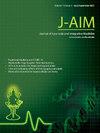Investigation on antineoplastic potential of Barleria lupulina Lindl: From phytochemical profiling to molecular dynamics simulation assessment
IF 1.9
Q3 INTEGRATIVE & COMPLEMENTARY MEDICINE
引用次数: 0
Abstract
Background
Barleria lupulina, a medicinal plant of India, South China and Southeast Asia, is known for its antioxidant and cytotoxic abilities. Although this plant has shown significant promise as an anticancer agent, the underlying mechanisms of action are yet to be explored. Objective: This study aimed to assess antiproliferative and proapoptotic potential of B. lupulina leaf extract with understanding of cellular and molecular mechanisms.
Materials and methods
The ethanolic extract was characterized using liquid chromatography-mass spectrometry and its anticancer activity was then assessed against Caco-2 colon cancer and A549 lung cancer cell lines.
Results
Phytochemical analysis of the extract revealed the presence of acetylbarlerin, decaffeoylacteoside, gallic acid, ipolamiide, leonuriside A, shanzhiside, and vanillic acid. The extract showed concentration-dependent cytotoxicity against both cancer cells. It induced early apoptosis at lower concentrations and late apoptosis at higher concentrations. Moreover, the extract noticeably reduced reactive oxygen species and mitochondrial membrane potential in a concentration-dependent way. The Western blot and quantitative reverse transcription polymerase chain reaction showed upregulation of Bax, caspase-8, caspase-9, and cluster of differentiation 95, and downregulation of Bcl-2. Molecular docking studies revealed that decaffeoylacteoside, gallic acid, and vanillic acid exhibited dual affinities for both caspase-8 and caspase-9, while acetylbarlerin, ipolamiide, leonuriside A, and shanzhiside showed selective affinities only for caspase-9.
Conclusion
The ethanolic leaf extract shows significant cytotoxic and proapoptotic activities, confirming its potential as a useful resource of bioactive compounds against cancer. Nevertheless, more in-depth investigations are necessary to realize the full potential of this medicinal plant for cancer therapy.
狼疮芽孢杆菌抗肿瘤潜能的研究:从植物化学谱分析到分子动力学模拟评价
狼疮barleria lupina是印度、华南和东南亚的一种药用植物,以其抗氧化和细胞毒性而闻名。虽然这种植物已经显示出作为抗癌剂的重要前景,但其潜在的作用机制还有待探索。目的:研究狼疮叶提取物的抗增殖和促凋亡作用,探讨其细胞和分子机制。材料与方法采用液相色谱-质谱联用技术对乙醇提取物进行了表征,并对Caco-2结肠癌和A549肺癌细胞株进行了抑癌活性评价。结果植物化学分析显示,提取物中含有乙酰巴勒蛋白、脱咖啡因酰乳糖苷、没食子酸、异丙酰胺、枸橼酸苷A、山芝苷和香草酸。提取物对两种癌细胞的细胞毒性均呈浓度依赖性。低浓度诱导早期细胞凋亡,高浓度诱导晚期细胞凋亡。此外,提取物以浓度依赖性的方式显著降低活性氧和线粒体膜电位。Western blot和定量逆转录聚合酶链反应显示Bax、caspase-8、caspase-9、cluster of differentiation 95表达上调,Bcl-2表达下调。分子对接研究发现,脱咖啡酰乳糖苷、没食子酸和香草酸对caspase-8和caspase-9具有双重亲和力,而乙酰barlerin、ipolamide、leonuriside A和山芝苷仅对caspase-9具有选择性亲和力。结论乙醇提取物具有显著的细胞毒活性和促凋亡活性,具有开发抗癌活性物质的潜力。然而,为了充分发挥这种药用植物治疗癌症的潜力,还需要进行更深入的研究。
本文章由计算机程序翻译,如有差异,请以英文原文为准。
求助全文
约1分钟内获得全文
求助全文
来源期刊

Journal of Ayurveda and Integrative Medicine
INTEGRATIVE & COMPLEMENTARY MEDICINE-
CiteScore
4.70
自引率
12.50%
发文量
136
审稿时长
30 weeks
 求助内容:
求助内容: 应助结果提醒方式:
应助结果提醒方式:


